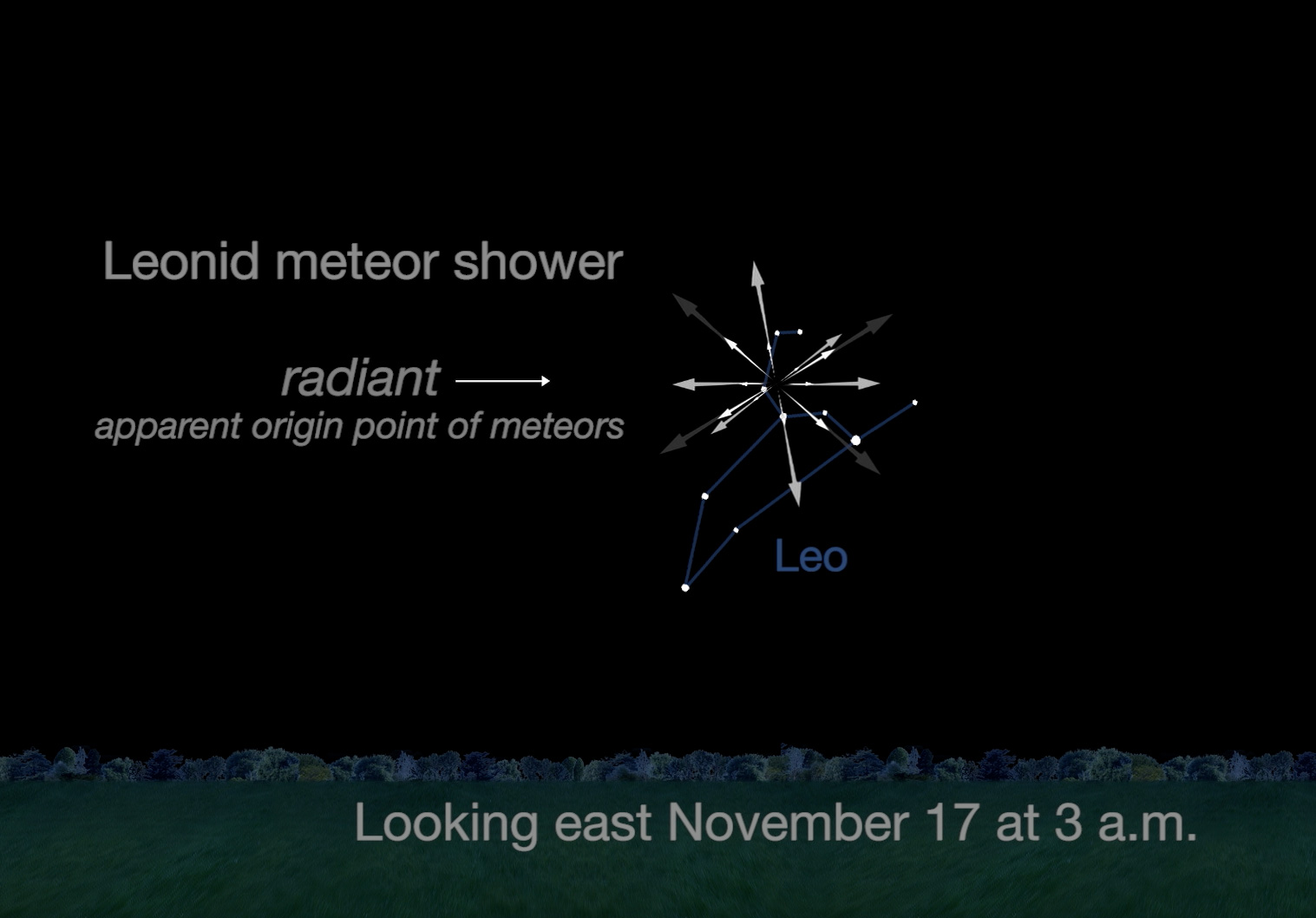The 2018 Leonid Meteor Shower Peaks This Weekend! Here's What to Expect
Come early Sunday morning (Nov. 18), the famous Leonid meteor shower will reach its peak, with lesser numbers expected on the preceding and following mornings.
According to Margaret Campbell-Brown and Peter Brown in the 2018 Observer's Handbook of the Royal Astronomical Society of Canada, Earth will pass through the thickest part of the Leonid swarm at 7 p.m. EST (2300 GMT) on Nov. 17. But the best time to look will be during the after-midnight hours of Sunday morning, once the source the meteors appear to stream from, called the radiant, comes above the horizon for observers in North America. The meteors appear to fly away from a point located within the Sickle of Leo (hence the name "Leonids").
Actually, the very best time to observe the Leonids is as close to dawn as possible. This is when viewers will be able to avoid glare from a waxing gibbous moon (which sets before 2 a.m. local time) and the radiant will climb well up in the southeastern sky. [Leonid Meteor Shower: When, Where & How to See It]

Under ideal dark-sky conditions, a single observer can expect to see about 10 to 15 of these ultraswift meteors each hour. They ram into our upper atmosphere at 45 miles (72 kilometers) per second — faster than any other meteor shower. As such, as many as half leave visible trails, and every once in a great while you might be treated to an outstandingly bright meteor (called a "fireball") or a meteor that silently explodes in a strobe-like flash along its path (called a "bolide"). Such meteors become so bright they can cast distinct shadows.
Observing tips
Since November mornings tend to be quite chilly, verging on downright cold, the best suggestion is to be sure and bundle up. The best piece of equipment for meteor watching is a long lounge chair in which you can lie back and look up without putting any stress on your neck. Look up into the sky, keep your eyes moving around and don't stare at any one place. Pretty soon you'll see a streak in the sky; mentally trace the streak backward. When another streak comes by, trace that backward also and see if it came from the same region of the sky as the first.
By the time a third streak appears, you should be able to verify that the emanation point is indeed within the Sickle, a backward question-mark pattern of stars that marks the head and mane of Leo, the Lion.
The past
What most people remember about the Leonids are the spectacular meteor displays that they staged during the 1998 through 2002 time frame. In some cases, meteors fell at rates of up to 3,000 per hour! The cause of these stupendous displays was Earth's interaction with dense streamers of dust trailing immediately behind Comet 55P/Tempel-Tuttle, which sheds dusty comet debris into space each time it passes the sun at roughly 33-year intervals. The comet reached the far end of its orbit, called aphelion, in 2014, so the Leonids have been weak in recent years.
Get the Space.com Newsletter
Breaking space news, the latest updates on rocket launches, skywatching events and more!
The future
Unfortunately, on its way back in toward the sun, the comet will pass close to Jupiter, whose potent gravitational field will noticeably perturb the orbit of the comet and its accompanying dense trails of dust. So, stupendous "storms" of meteors are not likely to occur on the next Leonid cycle. Still, there is a chance of some significant activity. Russian meteor expert Mikhail Maslov has predicted that on Nov. 19, 2034, dust trails shed by the comet in 1699 and 1866 will partially overlap upon their interaction with Earth, possibly producing meteor rates in the many hundreds per hour. Not a meteor "storm," but still potentially a very impressive display.
Mark your calendars!
Editor's note: If you snap an amazing Leonid meteor shower photo you'd like to share with Space.com and our news partners for a possible story or image gallery, please send your photos to our staff at spacephotos@futurenet.com.
Joe Rao serves as an instructor and guest lecturer at New York's Hayden Planetarium. He writes about astronomy for Natural History magazine, the Farmers' Almanac and other publications, and he is also an on-camera meteorologist for Verizon FiOS1 News in New York's Lower Hudson Valley. Follow us on Twitter @Spacedotcom and on Facebook. Original article on Space.com.
Join our Space Forums to keep talking space on the latest missions, night sky and more! And if you have a news tip, correction or comment, let us know at: community@space.com.

Joe Rao is Space.com's skywatching columnist, as well as a veteran meteorologist and eclipse chaser who also serves as an instructor and guest lecturer at New York's Hayden Planetarium. He writes about astronomy for Natural History magazine, Sky & Telescope and other publications. Joe is an 8-time Emmy-nominated meteorologist who served the Putnam Valley region of New York for over 21 years. You can find him on Twitter and YouTube tracking lunar and solar eclipses, meteor showers and more. To find out Joe's latest project, visit him on Twitter.
